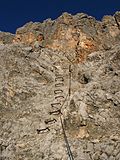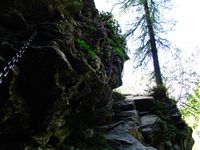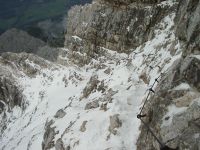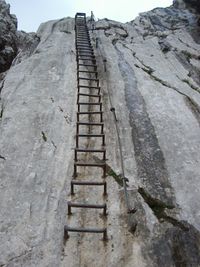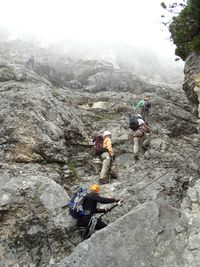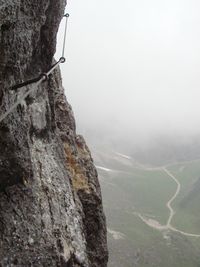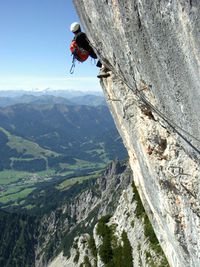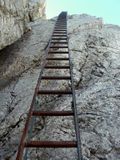Proposal:Via ferrata
| Via_Ferrata | |
|---|---|
| Proposal status: | Draft (under way) |
| Proposed by: | Kaspi |
| Tagging: | highway=via_ferrata |
| Applies to: | linear, node |
| Definition: | A mountain route equipped with fixed cables, stemples, ladders, and bridges. |
| Statistics: |
|
| Rendered as: | 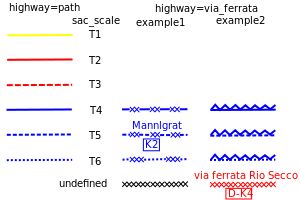 symbol for overlay: symbol for overlay: |
| Draft started: | 2009-05-11 |
| Proposed on: | first proposed 2010-08-22, continuously update since than |
Many parts of this draft are "in use", consider adding/moving stable sections of this draft to highway=via_ferrata and via_ferrata_scale=*
Propose
- highway=via_ferrata + via_ferrata_scale=* - this part of the proposal is fairly mature and in use
- relation of type=route, route=via_ferrata - this part is in draft stage
This is an updated draft, ancient proposal was here Proposed features/via ferrata version 1 RFC e-mail sent on tagging list
Rationale
There is no completely agreed tagging scheme for via ferratas in OSM. Some easier ferratas could be mapped as highway=path with additional keys describing difficulty but this is inappropriate for the very difficult ferratas which have more similarities to climbing routes, require ferrata kits and skills and are unsuitable for casual hikers, bicycles, horses and anything else which is by default allowed on highway=path. Also, highway=path is already fraught with enough confusion (see eg Path controversy) and used for anything from roadside bike paths in cities to demanding alpine routes.
Hence highway=via_ferrata is proposed. There is some overlap of easy ferratas and difficult alpine paths this should not pose any fundamental problem as explained bellow.
Additionally, a as a new enhancement a relation of type route type=route, route=via_ferrata is proposed. This allows more flexible and precise mapping of ferratas where some sections are steps, ladders, walkable paths or climbing routes.
Description
See the full definition on wikipedia [1]
A via ferrata is a route equipped with fixed cables, stemples, ladders, and bridges in order to increase ease and security for climbers. These via ferrata require equipment : climbing harness, shock absorber and two short lengths of rope, but do not require a long rope as for climbing.
Alternatives
For paths with safety ropes which do not require special equipment see the approved proposal safety measures on hiking trails.
Especially some old "Klettersteige" may be more appropriately mapped like this, some of them have not much more in common with a ferrata than the (translated) name.
Main tags
highway=via_ferrata by default implies:
- unsuitable/forbidden for bicycles, horses and similar
- wheelchair=no
Easy ferratas which are usable by hikers may also be mapped with highway=path as described in the next section. If mapped as path sac_scale=* is required for technical reasons.
With the use of the route=ferrata relation or the ferrata access tags segments of the ferrata could be tagged as appropriate using any combination of highway=path, highway=via_ferrata, climbing=route depending on the difficulty and appearance of the sections.
Criteria for taging as either via_ferrata or path
There is some overlap between easy ferratas and difficult/secured hiking paths. If you have a hard time deciding which one is more appropriate than the mistake if you choose either of those is probably not a big one.
When deciding whether to map something as highway=via_ferrata or highway=path with safety measures on hiking trails you may consider following points:
- use highway=via_ferrata where people commonly use ferrata kits
- use highway=path where a ferrata kit is not required or none or few people use ferrata kits
- a path is way where a hiker can walk without a ferrata kit and without extensive use of arm muscles and climbing techniques. The difficulty of routes mapped as path should not exceed what can be properly described by sac_scale=*
- do not use highway=path instead of highway=via_ferrata just for the renderer! At least OpenAndroMaps, OsmAnd, OpenTopoMap, Hike & Bike Map and MRI render via ferrata.
If tagging easy ferratas as highway=path it is important to tag the access and usability for pedestrians, bicycles, horses etc as well because paths are by default expected to be open to all non-motorized vehicles.
Tagging as route=via_ferrata relation
Create a relation of type=route, route=via_ferrata and add all ways belonging to the ferrata to it. The ways can be of different types such as highway=via_ferrata, highway=path, climbing=route, steps or other as appropriate (do not tag for the mapnik renderer though). Add difficulty rating to the segments, then add the segments members to the relation with an "empty" role or a forward/backward as role for one way segments.
The relation can also have name, description and other common tags as appropriate.
The use of the ferrata relation is currently in an early draft stage and unlike other parts of this proposal no tile renderers support it right now. ferrata relations are imported and rendered on XCTrails.org however. It is designed to be similar to the relation route=hiking form where further inspiration can be drawn.
In particular for relations, it is not always clear nor can it be reliably calculated (from elevation or way/one-way direction) where the ferrata actually starts. Hence, a tag via_ferrata=start on the respective node has become common.
Seasonal Access
Some ferratas are seasonally closed due to a variety of restrictions (wildlife, snow/ice, etc.). These restrictions are typically posted on physical signs in the vicinity of the respective ferratas.
As used for other ways (and relations), access:conditional=* in conjunction with the opening_hours=* syntax can be used to map such restrictions.
Rating via ferrata's difficulty
There is no "world wide scale" for via_ferrata difficulty, The "German" Huesler scale (as taken from Wikipedia 1 ) seems to be the only one with quite objective qualifications. Therefore it is used for OSM with the addition of very little difficulty / French F.
| Key | Value | Element | Description | Conversion | Examples |
|---|---|---|---|---|---|
| via_ferrata_scale | 0 | Subjective Difficulty very little
Way/Surroundings Flat to steep, Exposed sections possible Securance Steel cables, chains, stemples (metal rungs) and partly short iron ladders. Short and easy. Exigencies Surefootedness and being free from giddiness recommendable. No problem for unsporty Equipment Basic Via-Ferrata kit may be recommended but is not used by most people |
French:F
German: none - very easy |
||
| via_ferrata_scale | 1 | Subjective Difficulty little
Way/Surroundings Flat to steep, usually rocky. Exposed sections possible Securance Steel cables, chains, stemples (metal rungs) and partly short iron ladders. Most parts are usable without using the artificial securance Exigencies Surefootedness and being free from giddiness recommendable. Being as sporty as a white collar employee enough (for the ferrata itself, depending on the overall journey it may be different) Equipment Basic via ferrata kit recommended. Experienced ferrata users are often met without self-securance |
French: PD
German: A-K1 - little difficult |
||
| via_ferrata_scale | 2 | Subjective Difficulty litte to slightly difficult, in parts a bit demanding or exhausting
Way/Surroundings steep rocky area, in parts small steps, exposed terrain is common Securance Steel cables, chains, stemples, Tritttifte??, long ladders (also vertical). Usage bypassing securances possible, but then climbing up to UIAA III / French 3 are to be expected Exigencies Same as for 1, but better shape and a bit more power and endurance in legs and arms are advantageous Equipment Via ferrata kit recommended. Usage also possible as rope team |
French: AD
German: B-K2 - moderately difficult |
||
| via_ferrata_scale | 3 | Subjective Difficulty largely difficult, exigeant and straining
Way/Surroundings steep to very steep rock faces, mostly only small steps, longer or many exposed sections Securance Steel cables, stemples, Trittstifte, often longer ladders, even overhanging ladders and stemples to be expected, sometimes in vertical sections only steel cables existing, Usable bypassing securances usually possible, but then climbing up to UIAA IV/ French 4 is the norm Exigencies Good shape, longer ascents in difficult sections are demanding as ferratas of this difficulty are already among the bigger ferratas (sic! better translation?) Equipment Via ferrata kit heavily recommended. Unexperienced or children should eventually even be roped in |
French: D
German: C-K3 - difficult |
||
| via_ferrata_scale | 4 | Subjective Difficulty very difficult, very demanding and very straining
Way/Surroundingsvertical, often overhanging areas, largely very exposed Securance Steel cables, stemples, Trittstifte (often spaced with large distance), in exposed section often no more than a steel cable Exigencies Same as for 3, but general good body shape needed. Good power in hands and arms as longer vertical to overhanging sections are possible. Also small climbing sections up to difficulty UIAA II / French 2 may need to be cleared. Equipment Via ferrata kit obligatory, even very experienced via ferrata users will be met in a rope team. Not recommended for children or inexperienced |
French: TD
German: D-K4 - very difficult |
||
| via_ferrata_scale | 5 | Subjective Difficulty Extremely difficulty because very straining and exceedingly arduous.
Way/Surroundings Vertical to Overhanging; consistently exposed, very small steps or slab climbing Securance As for 4 but much more climbing parts Exigencies Lots of power in hands (fingers), arms and legs. Increased levels of fitness, flexibility needed. Long section may need to be cleared with main weight carried by the arms Equipment Via ferrata kit obligatory. Rope teams especially for those sections without steel ropes or other securances considerable; not recommendable for beginners or children |
French: ED
German: E-K5 - extreme difficulty |
||
| via_ferrata_scale | 6 | Subjective Difficulty More than extremely difficulty because very straining and exceedingly arduos and very good climbings skills are needed.
Way/Surroundings Largely Overhanging; exposed, very small steps or slab climbing Securance As for 5 combined with climbing Exigencies Like 5, but good climbing technique obligatory Equipment Via ferrata kit obligatory. Top rope recommended. Only for people that feel safe and have experience using scale 5 ferratas. Note currently the only known ferrata of this difficulty in the European Alps is found on the Buergeralm Klettersteig (Austria) with "Arena Variante" 1 |
French: ABO
German: F-K6 more than extreme difficulty |
- Note: You can add a + or a - after the value to indicate that the via ferrata is on bottom or top of the grade.
- sac_scale=* may be added where advanced hikers might still securely use the via ferrata.
- Note: I took out the two French beginner sections as the German scale does not make a differentiation. I propose to enter it as 0 - very easy with a classification like "Basically demanding_mountain_hiking but in exposed sections. For frightened or inexperienced people steel cables or short ladders or a few stemples might be part of the way. Is in general not considered as a via ferrata but a normal way featuring via ferrata objects. Via Ferrata kit in general not used and only insecure people use the eventual steel cables. --Extremecarver 18:29, 18 November 2010 (UTC)
Details along the way
Those tags have to be added to the main one if used (i.e not alone) some are already approved so they are part of this proposal as an extension use
| Key | Value | Element | Comment | Example |
|---|---|---|---|---|
| bridge | yes | An unspecified bridge type along the via ferrata route | 
| |
| bridge:structure | simple-suspension | "Tibetan" or other very simple hanging/swinging bridges including 2 or more rope bridges see bridge:structure=simple-suspension for more details | 
| |
| cable_number | 2 or more | For cable bridges the total number of cables, in addition to bridge=yes and bridge:structure=simple-suspension |  (here a 3 cable bridge) (here a 3 cable bridge)
| |
| aerialway | zip_line | A zip line along the via ferrata route see aerialway=zip line | ||
| oneway | yes | If the via ferrata is not allowed both ways | ||
| ladder | yes/length in m | Steel ladder, see ladder=* | ||
| rungs | yes/amount | Rungs, stemples, pins | 
| |
| tunnel | yes | A tunnel/cave along the via ferrata route | 
| |
| natural | cave | Via ferrata route through a cave (see proposal natural=cave) | 
| |
| overhang | yes/no/ length in m | Overhanging sections of significant length |
Related tags
History and alternatives
See Tag:highway=via_ferrata#Alternatives and history for overview of history and alternatives.
